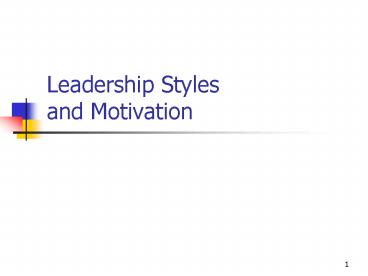Leadership Styles and Motivation - PowerPoint PPT Presentation
1 / 20
Title:
Leadership Styles and Motivation
Description:
Two Main Theories of Motivation. Maslow's Hierarchy of Needs ... Maslow's Hierarchy. More basic needs must be met first. ( food, housing, safety) ... – PowerPoint PPT presentation
Number of Views:34
Avg rating:3.0/5.0
Title: Leadership Styles and Motivation
1
Leadership Styles and Motivation
2
Agenda for Today
- Situation Leadership Style Assessment
- Introduce the model
- Examine our leadership styles
- Motivation
- Discuss models of motivation
- Apply these to the health care setting
- Discuss how these relate to our study of
leadership styles
3
Situation Leadership
- 1. Developed by Dr. Paul Hersey, after years of
studying the leadership behavior. - 2. Leadership has been characterized as
- Autocratic vs. Democratic
- Employees Oriented vs. Production oriented
- 3. Hersey dispels this either-or dichotomy
4
Hersey look at leadership in Two Dimensions
- 1. Task Behavior
- 2. Relationship Behavior
5
Level of Readiness
- 1. Varies according to the specific task to be
performed. - 2. So, the leader may need to provide differing
levels of supervision, for different tasks, for
the same person.
6
Leadership as a dynamic interplay..
- Situational leadership is based on the
interplay among - a. The amount of direction (task behavior)
- b. The amount of socio-emotional support
(relationship behavior) - c. The readiness level that followers
exhibit - Paul Hersey, Situation Leadership A Summary,
1993.
7
Central Concept of Situational Leadership
- As the level of readiness of a follower
increases, the leader should reduce task behavior
and increase relationship behavior. - Readiness is a continuum which moves back and
forward under different circumstances.
8
Leadership Styles
- Most individuals have either primary or secondary
styles from within - a. Telling HT/LR
- b. Selling HT/HR
- c. Participating LT/HR
- d. Delegating LT/LR
9
Modifying Levels of Readiness
- A gradual, two step process
- Reduce structure
- If performance is adequate, increase
socio-emotional support.
10
Motivation and Leadership Style
- If a program is to work effectively, managers
must pay particular attention to those factors
effecting staff performance. - Managers must look at what motivates staff, and
also at how their leadership style effects staff
performance.
11
What is his motivation?
12
Or his?Lets look at some theories.
13
Two Main Theories of Motivation
- Maslows Hierarchy of Needs
- Herzbergs Hygiene vs. Motivators theory
14
Maslows Hierarchy
Self-Actualization Needs
Esteem Needs
Societal Needs
Safety Needs
Physiological Needs
15
Key point in Maslows Hierarchy
- More basic needs must be met first. (food,
housing, safety) - Only then can someone be motivated through such
factors as social regard or esteem, and finally,
self-actualization.
16
HerzbergsMotivators vs. Dissatisfiers
- Motivators
- Achievement
- Recognition
- Work itself
- Responsibility
- Advancement
- Self-improvement
- Dissatisfiers
- Company policy
- Efficient Administration
- Supervision
- Relationship with supervisor
- Working conditions
- Status?
- Pay???
17
More on Herzbergs Dissatisfiers vs.
Motivators Theory
- Dissatisfiers are those factors necessary to
work well. - Their absence causes dissatisfaction,
- However, improving these factors does not
necessarily lead to increased satisfaction and
improved performance. - Motivators are those factors that create
satisfaction, and are likely to lead to improved
performance.
18
Maslow and Herzberg
- These two theories are similar as many of the
factors they highlight are the same. - Herzberg points out that certain factors reach a
kind of saturation point beyond which improving
that factor will not increase satisfaction or
performance.
19
Essentials of Motivation
- Staff must have a clear understanding of their
role in the program - Staff must have a clear understanding of the
expectations for them - There must be a fair system of rewards/incentives
- There must be feedback to the staff on their
performance
20
Leadership and Motivation
- The most effective leader will be able to
understand what motivates an individual employee,
on a specific task. Does the employee need - More direction?
- More autonomy and decision-making authority?
- More pay?
- Some combination of the above? (and, is this
feasible?)































